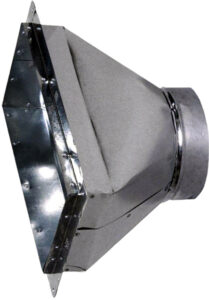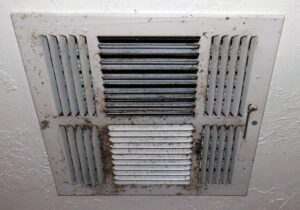Is Your HVAC System contributing to Attic Moisture Issues?
Your air-conditioning system produces cold air which helps to cool the interior portions of your house while lowering the humidity levels.
Ducts that are leaking, in direct contact with each other or lying on the attic floor create potential points for moisture condensation. Ducts need to be physically separated with an air gap. Simply placing a scrap piece of insulation to separate the ducts will only give you wet insulation. Another source for the formation of moisture is the  supply register boot itself. Most HVAC boots have a very low R-value. They are constructed of thin sheet metal and most have multiple leaks at the seams and joints. The insulation provided is thin, loosely fit, and offers very little insulation. If there is an air leak where the duct connects to the supply register (usually in a ceiling separating conditioned and unconditioned spaces) condensation will form there as well.
supply register boot itself. Most HVAC boots have a very low R-value. They are constructed of thin sheet metal and most have multiple leaks at the seams and joints. The insulation provided is thin, loosely fit, and offers very little insulation. If there is an air leak where the duct connects to the supply register (usually in a ceiling separating conditioned and unconditioned spaces) condensation will form there as well.
If you are seeing mold forming at your supply registers, this is very possibly what is happening.
this is very possibly what is happening.
There are lot of HVAC technicians out there. It is important when choosing one to get someone that is truly qualified to diagnose and repair any issues. One recommendation would be to find an authorized dealer for the brand of air conditioning unit that you are currently using. Typically they are better trained and will know more about that particular brand than most anyone else. It is also a good idea when searching for a qualified HVAC technician to visit the Better Business Bureau. Companies with an A+ rating will typically be a good company to hire.
The HVAC ducts can also be a source of moisture issues. The recommended R value for return and supply ducts in our area is R-8. HVAC ducts with less than an R–8 value are more prone to sweating.

